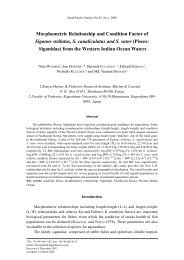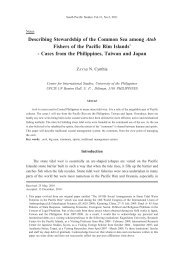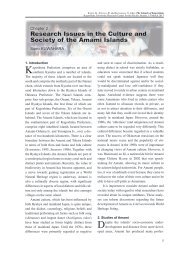marine resources in yap state, fsm : the current status of customary ...
marine resources in yap state, fsm : the current status of customary ...
marine resources in yap state, fsm : the current status of customary ...
You also want an ePaper? Increase the reach of your titles
YUMPU automatically turns print PDFs into web optimized ePapers that Google loves.
Kagoshima University Research Center for <strong>the</strong> Pacific Islands, Occasional Papers No.34, 113-116, 2001<br />
Part 1, Section 3, Report 5. The Progress Report <strong>of</strong> <strong>the</strong> 1999 Survey <strong>of</strong> <strong>the</strong> Research Project<br />
“Social Homeostasis <strong>of</strong> Small Islands <strong>in</strong> an Island-zone”<br />
113<br />
<br />
<br />
Andy TAFILEICHIG and Akio INOUE<br />
Abstract<br />
Yap State, one <strong>of</strong> <strong>the</strong> four constituent <strong>state</strong>s <strong>of</strong> <strong>the</strong> Federated States <strong>of</strong> Micronesia , consists <strong>of</strong> a<br />
relatively large island and a few smaller atolls to 600 miles north east <strong>of</strong> <strong>the</strong> ma<strong>in</strong> island. This paper<br />
focuses on legislation applied to <strong>mar<strong>in</strong>e</strong> <strong>resources</strong> and coastal fisheries and <strong>the</strong> scope <strong>of</strong> <strong>resources</strong><br />
management <strong>in</strong> several islands and islets <strong>of</strong> Yap State. The traditonal conservation systems are also<br />
discussed <strong>in</strong> relation to <strong>the</strong> protection <strong>of</strong> <strong>in</strong>habitants’ fish<strong>in</strong>g right.<br />
Key words: coastal fisheries, fish<strong>in</strong>g right, <strong>mar<strong>in</strong>e</strong> <strong>resources</strong>, traditional systems, Yap<br />
Yap State, one <strong>of</strong> <strong>the</strong> four constituent <strong>state</strong>s <strong>of</strong> <strong>the</strong> Micronesian Federation, consists <strong>of</strong> a<br />
relatively large island and a few smaller atolls up to 600 miles north east <strong>of</strong> <strong>the</strong> ma<strong>in</strong> island. This<br />
paper focuses on legislation applied to fisheries <strong>resources</strong> and coastal conservation and <strong>the</strong> scope<br />
<strong>of</strong> management <strong>in</strong> several islands and islets <strong>of</strong> Yap State.<br />
Yap has a very complex <strong>mar<strong>in</strong>e</strong> and fisheries management structure. The Government <strong>of</strong><br />
Yap is made up <strong>of</strong> four branches; <strong>the</strong> executive, legislative, judicial and <strong>customary</strong>, <strong>in</strong> contrast<br />
to her o<strong>the</strong>r three sister <strong>state</strong>s, Pohnpei, Chuuk and Kosrae, which have only <strong>the</strong> first three<br />
branches. Yap’s fourth branch is paramount: it has a very strong say over custom, behavior and<br />
development. It is headed by a Council <strong>of</strong> Chiefs, consist<strong>in</strong>g <strong>of</strong> chiefs from Yap ma<strong>in</strong> islands and<br />
neighbor<strong>in</strong>g islands. The chiefs are considered <strong>the</strong> upholders <strong>of</strong> Yapese custom and, accord<strong>in</strong>g<br />
to <strong>the</strong> Constitution <strong>of</strong> Yap State (Article III, Section 2), “Due recognition shall be given to tradition<br />
and customs <strong>in</strong> provid<strong>in</strong>g a system <strong>of</strong> law, and noth<strong>in</strong>g <strong>in</strong> this Constitution shall be constructed<br />
to limit or <strong>in</strong>validate any recognized tradition or custom”. A pr<strong>in</strong>cipal function <strong>of</strong> <strong>the</strong><br />
council <strong>of</strong> chiefs is to consider developments <strong>in</strong> Yap which affect <strong>the</strong> lives and well-be<strong>in</strong>g <strong>of</strong> <strong>the</strong><br />
people, to advise <strong>the</strong> Government on matters affect<strong>in</strong>g customs, and to resolve problems and disputes<br />
<strong>in</strong> <strong>customary</strong> ways whenever possible.<br />
Thus <strong>in</strong> Yap State, a traditional political structure has been partially <strong>in</strong>tegrated <strong>in</strong>to a modern<br />
representative government. The traditional rights <strong>of</strong> <strong>the</strong> people are protected by <strong>the</strong> Yap State<br />
Constitution, but <strong>the</strong> Council <strong>of</strong> Chiefs has <strong>the</strong> power to veto legislation promulgated by <strong>the</strong><br />
elected legislature when matters <strong>of</strong> custom or tradition are concerned (Article III, Yap<br />
Constitution). In relation to <strong>mar<strong>in</strong>e</strong> <strong>resources</strong>, <strong>the</strong> Constitution <strong>state</strong>s: “The State recognizes traditional<br />
rights and ownership <strong>of</strong> natural <strong>resources</strong> and areas with<strong>in</strong> <strong>the</strong> <strong>mar<strong>in</strong>e</strong> space <strong>of</strong> <strong>the</strong> State,<br />
with<strong>in</strong> and beyond 12 miles from <strong>the</strong> island basel<strong>in</strong>es. No action may be taken to impair <strong>the</strong>se<br />
traditional rights and ownership, except <strong>the</strong> State Government may provide for <strong>the</strong> conservation<br />
and protection <strong>of</strong> natural <strong>resources</strong> with<strong>in</strong> <strong>the</strong> <strong>mar<strong>in</strong>e</strong> space <strong>of</strong> <strong>the</strong> State with<strong>in</strong> 12 miles from <strong>the</strong><br />
island basel<strong>in</strong>es” (Article XIII, Section 5).<br />
The preamble to Yap’s Constitution recognizes traditional heritage and village life as <strong>the</strong><br />
foundation <strong>of</strong> Yapese society and commits <strong>the</strong> Government to an <strong>in</strong>tegration <strong>of</strong> modern
114 Andy TAFILEICHIG and Akio INOUE<br />
technology with traditional ways so as to benefit both <strong>the</strong> present and future generations. Yap<br />
State’s waters are divided <strong>in</strong>to <strong>in</strong>ternal waters and <strong>the</strong> State Fisheries Zone. The <strong>in</strong>ternal waters<br />
extend from <strong>the</strong> shore to <strong>the</strong> island basel<strong>in</strong>es, and <strong>the</strong> State Fishery Zone extends 12 miles seaward<br />
from <strong>the</strong> island basel<strong>in</strong>es. The island basel<strong>in</strong>es are def<strong>in</strong>ed for an island or atoll with a<br />
fr<strong>in</strong>g<strong>in</strong>g or barrier reef as a “l<strong>in</strong>e follow<strong>in</strong>g <strong>the</strong> contour <strong>of</strong> <strong>the</strong> seaward edge <strong>of</strong> <strong>the</strong> reef system”<br />
(Yap State Code, Title 18 and 27), that is, <strong>the</strong> edge <strong>of</strong> <strong>the</strong> outer reef. Any resource management<br />
<strong>in</strong>volv<strong>in</strong>g <strong>the</strong> utilization <strong>of</strong> <strong>in</strong>shore <strong>mar<strong>in</strong>e</strong> <strong>resources</strong> must be accepted and approved by <strong>the</strong><br />
Council <strong>of</strong> Chiefs. However, <strong>the</strong> ambiguous word<strong>in</strong>g <strong>of</strong> this section makes it unclear whe<strong>the</strong>r <strong>the</strong><br />
government can <strong>in</strong>tervene on matters concern<strong>in</strong>g resource conservation and protection <strong>in</strong> <strong>in</strong>ternal<br />
waters.<br />
Despite differences <strong>in</strong> culture and language, Yap and its neighbor<strong>in</strong>g islands have traditionally<br />
been l<strong>in</strong>ked by a system <strong>of</strong> political, economic and religious ties. The tribute system, which<br />
ceased some time around <strong>the</strong> turn <strong>of</strong> <strong>the</strong> century, obliged <strong>the</strong> neighbor<strong>in</strong>g islanders, at specified<br />
<strong>in</strong>tervals, to send tribute to <strong>the</strong> chief <strong>of</strong> one district village on Yap, as well as religious gifts to<br />
specific religious functionaries. Gifts from specific families to <strong>the</strong>ir Yapese overlords were also<br />
required. Follow<strong>in</strong>g is a brief outl<strong>in</strong>e <strong>of</strong> traditional neighbor<strong>in</strong>g island social organization as it<br />
relates to <strong>mar<strong>in</strong>e</strong> usage and tenure. These systems are still <strong>in</strong> effect, but are <strong>in</strong>creas<strong>in</strong>gly weakened<br />
by <strong>the</strong> effects <strong>of</strong> <strong>current</strong> political, economic, religious and educational systems. With <strong>the</strong> <strong>in</strong>troduction<br />
<strong>of</strong> Christianity, especially after World War II, a number <strong>of</strong> cultural restrictions on<br />
<strong>mar<strong>in</strong>e</strong> resource usage were lifted. This, coupled with an <strong>in</strong>creas<strong>in</strong>g <strong>in</strong>volvement <strong>of</strong> people <strong>in</strong> <strong>the</strong><br />
cash economy, has weakened some aspects <strong>of</strong> <strong>the</strong> traditional systems. The system <strong>of</strong> control and<br />
tenure <strong>of</strong> <strong>mar<strong>in</strong>e</strong> areas and <strong>resources</strong> fall <strong>in</strong>to three broad and overlapp<strong>in</strong>g categories. In all islands,<br />
however, <strong>mar<strong>in</strong>e</strong> areas are not “owned” by <strong>the</strong> chief(s), but are only managed by <strong>the</strong>m, <strong>in</strong><br />
consultation with o<strong>the</strong>r clan elders, for <strong>the</strong> benefit <strong>of</strong> <strong>the</strong> whole clan.<br />
On Ulthi Atoll, for example, all <strong>the</strong> reef and lagoon areas belong to <strong>the</strong> highest rank<strong>in</strong>g clan.<br />
This clan’s chief also presides as <strong>the</strong> paramount chief <strong>of</strong> <strong>the</strong> atoll. The <strong>mar<strong>in</strong>e</strong> areas <strong>of</strong> <strong>the</strong> atoll<br />
are, however, divided <strong>in</strong>to a number <strong>of</strong> sections which are controlled by <strong>the</strong> chiefs <strong>of</strong> each clan.<br />
Members <strong>of</strong> any clan have <strong>the</strong> right to fish <strong>in</strong> any sections with<strong>in</strong> <strong>the</strong> atoll that belong to <strong>the</strong>ir<br />
own clan.<br />
A slightly different tenure and rights system has been adopted on Woleai Atoll. Here, <strong>the</strong><br />
reef and lagoon are divided up and controlled by <strong>the</strong> rank<strong>in</strong>g clan <strong>in</strong> each island or village. There<br />
is no paramount chief who has jurisdiction over <strong>the</strong> entire atoll. The head <strong>of</strong> each rank<strong>in</strong>g clan,<br />
<strong>in</strong> consultation with o<strong>the</strong>r elders, controls its own areas, determ<strong>in</strong><strong>in</strong>g when and if <strong>the</strong>y should be<br />
closed, as well as decid<strong>in</strong>g upon communal fish<strong>in</strong>g. Individuals are able to fish with<strong>in</strong> <strong>the</strong>ir own<br />
clan’s areas at any time.<br />
The third form <strong>of</strong> tenure and use rights is exemplified Satawal Atoll. Here, <strong>the</strong> chiefs <strong>of</strong> <strong>the</strong><br />
three rank<strong>in</strong>g clans divide up <strong>the</strong> responsibilities for island affairs. One chief takes <strong>the</strong> role <strong>of</strong><br />
“chief <strong>of</strong> <strong>the</strong> sea”. He has <strong>the</strong> right to control <strong>the</strong> usage <strong>of</strong> <strong>mar<strong>in</strong>e</strong> <strong>resources</strong> and fish<strong>in</strong>g methods.<br />
The use <strong>of</strong> <strong>the</strong> fr<strong>in</strong>g<strong>in</strong>g reef area is open to anyone who wants to fish <strong>the</strong>re, but use <strong>of</strong> all o<strong>the</strong>r<br />
fish<strong>in</strong>g areas (mounts, un<strong>in</strong>habited atolls) require permission <strong>of</strong> <strong>the</strong> “chief <strong>of</strong> <strong>the</strong> sea”. The right<br />
to use <strong>the</strong> food <strong>resources</strong> <strong>of</strong> fish<strong>in</strong>g areas o<strong>the</strong>r than <strong>the</strong> fish<strong>in</strong>g reef belongs to <strong>the</strong> chief <strong>of</strong> <strong>the</strong><br />
sea.<br />
Social organization, especially as it relates to <strong>mar<strong>in</strong>e</strong> and o<strong>the</strong>r resource usage and tenure,<br />
is much more complicated than outl<strong>in</strong>ed above. Customary control <strong>of</strong> <strong>mar<strong>in</strong>e</strong> usage area is, for<br />
<strong>the</strong> most part, still strong <strong>in</strong> <strong>the</strong> neighbor<strong>in</strong>g islands. This can be attributed <strong>in</strong> part to <strong>the</strong>ir
Mar<strong>in</strong>e Resources <strong>in</strong> Yap State, FSM : The Current Status <strong>of</strong> Customary and Traditional Regulation 115<br />
remoteness, small size and greater reliance on subsistence fish<strong>in</strong>g. However, <strong>of</strong> considerable significance<br />
is <strong>the</strong> fact that <strong>the</strong> management and control <strong>of</strong> resource use <strong>in</strong> <strong>the</strong> neighbor<strong>in</strong>g islands<br />
have been cont<strong>in</strong>uously under traditional control; colonial powers, and, more recently, <strong>the</strong> constitutional<br />
government, have had m<strong>in</strong>imal <strong>in</strong>fluence. Traditional systems <strong>of</strong> <strong>mar<strong>in</strong>e</strong> tenure, fish<strong>in</strong>g<br />
rights, catch distribution, dispute resolution and award<strong>in</strong>g <strong>of</strong> punishments are still observed.<br />
However, <strong>the</strong>re has been a general relaxation <strong>in</strong> <strong>the</strong> control <strong>of</strong> some <strong>of</strong> <strong>the</strong> fish<strong>in</strong>g <strong>resources</strong> and<br />
fish<strong>in</strong>g rights.<br />
There is a lack <strong>of</strong> small-scale commercial fish<strong>in</strong>g <strong>in</strong> <strong>the</strong> neighbor<strong>in</strong>g islands <strong>of</strong> <strong>the</strong> type that<br />
occurs on Yap proper. This is partly due to <strong>the</strong> lack <strong>of</strong> opportunities, but, significantly, it is also<br />
a result <strong>of</strong> a fear that commercial fish<strong>in</strong>g will not leave enough reef fish for subsistence purposes.<br />
Some positive management actions taken on many <strong>of</strong> <strong>the</strong> neighbor<strong>in</strong>g islands have highlighted<br />
<strong>the</strong> responsibility <strong>of</strong> traditional authorities for <strong>mar<strong>in</strong>e</strong> management. In Ifik atoll <strong>the</strong> chiefs have<br />
banned <strong>the</strong> use <strong>of</strong> boats and outboard motors; only paddl<strong>in</strong>g and sail<strong>in</strong>g canoes are permitted.<br />
This is, <strong>in</strong> part, to control <strong>the</strong> level <strong>of</strong> <strong>mar<strong>in</strong>e</strong> <strong>resources</strong> exploitation and to help ma<strong>in</strong>ta<strong>in</strong> traditional<br />
skills.<br />
Many <strong>of</strong> <strong>the</strong> neighbor<strong>in</strong>g islands have banned <strong>the</strong> use <strong>of</strong> mon<strong>of</strong>ilament gill nets. When this<br />
type <strong>of</strong> net was first <strong>in</strong>troduced to <strong>the</strong> islands, it was quickly recognized that it was likely to result<br />
<strong>in</strong> overfish<strong>in</strong>g. It also would change <strong>the</strong> way net fish<strong>in</strong>g was conducted: from communal<br />
fish<strong>in</strong>g to fish<strong>in</strong>g by a few <strong>in</strong>dividuals. As a result, this type <strong>of</strong> net was banned. Spearfish<strong>in</strong>g with<br />
flashlights was also recognized by <strong>the</strong> chiefs and elders as a method that would allow <strong>the</strong> reef<br />
fish <strong>resources</strong> to be over-harvested. Many <strong>of</strong> <strong>the</strong> neighbor<strong>in</strong>g islands have thus banned flashlight<br />
spearfish<strong>in</strong>g.<br />
In Woleai Atoll, one area outside <strong>the</strong> atoll that regularly has schools <strong>of</strong> tuna can only be<br />
fished by pole and l<strong>in</strong>e from sail<strong>in</strong>g canoes; no troll<strong>in</strong>g boats are permitted <strong>the</strong>re. A number <strong>of</strong><br />
<strong>the</strong> islands customarily close sections <strong>of</strong> <strong>the</strong> reef after senior people die. These closures may last<br />
from a month to more than 12 months. While not specially aimed at fish restoration, <strong>the</strong>se closures<br />
do allow fish stocks on <strong>the</strong> reef to recover. On one islet <strong>of</strong> Woleai Atoll, <strong>the</strong> harvest<strong>in</strong>g <strong>of</strong><br />
coconut crab is prohibited, except for when <strong>the</strong> w<strong>in</strong>d blows from <strong>the</strong> west. Dur<strong>in</strong>g <strong>the</strong> westerly<br />
w<strong>in</strong>d season it is not possible to fish ei<strong>the</strong>r <strong>in</strong>side or outside <strong>the</strong> lagoon, and coconut crabs are<br />
<strong>the</strong>n used as ‘reserve’ food. This control has allowed <strong>the</strong> coconut crab population <strong>in</strong>crease considerably<br />
on that island. On Satawal, a raised coral island with only a fr<strong>in</strong>g<strong>in</strong>g reef and a very<br />
high population, a section <strong>of</strong> <strong>the</strong> reef is traditionally closed for long periods as a reserve for reef<br />
<strong>resources</strong>.<br />
These are only few examples <strong>of</strong> traditional control and <strong>customary</strong> law, which show that<br />
chiefs and elders, through <strong>the</strong> traditional system, are actively manag<strong>in</strong>g <strong>the</strong> atoll <strong>resources</strong> <strong>of</strong><br />
<strong>the</strong>ir islands.<br />
One advantage that <strong>the</strong> traditional system has over <strong>the</strong> legislative system is <strong>the</strong> ability to be<br />
flexible and to adjust quickly to chang<strong>in</strong>g circumstances. The legislative system is usually too<br />
rigid and slow to respond to chang<strong>in</strong>g circumstances.<br />
The Yapese clearly recognize that culture and natural <strong>resources</strong>, such as land, reef and<br />
coastal sea upon which <strong>the</strong>y depend, are fully <strong>in</strong>terw<strong>in</strong>ed, and that a healthy environment is <strong>the</strong><br />
foundation <strong>of</strong> a healthy culture.<br />
<br />
1) Andrew J. SMITH 1992. Federated States <strong>of</strong> Micronesia Mar<strong>in</strong>e Resources Pr<strong>of</strong>iles. 107pp.
116 Andy TAFILEICHIG and Akio INOUE<br />
FFA Report No. 92/17.<br />
2) Barry GOLDMAN 1994. Yap State Mar<strong>in</strong>e Resources and Coastal Management Plan. 131pp.<br />
Mar<strong>in</strong>e Resources Management Division.<br />
3) Mar<strong>in</strong>e Resources Management Division, Yap State Government 1987. A Survey <strong>of</strong><br />
Village Fishermen <strong>of</strong> Yap Proper. 67pp.<br />
4) William H.ALKIRE 1989. Lamotrek Atoll-<strong>in</strong>ter-island socioeconomic tie. 125pp, Waveland<br />
Press, N.Y.







